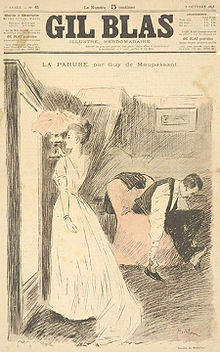The Necklace
| "The Necklace" | |
|---|---|

La Parure, illustration of the title page of the Gil Blas, 8 October 1893
|
|
| Author | Guy de Maupassant |
| Original title | "La Parure" |
| Country | France |
| Genre(s) | Short story |
| Publication date | 1884 |
"The Necklace" or "The Diamond Necklace" (French: La Parure) is an 1884 short story by French writer Guy de Maupassant. It is known for its twist ending, which was a hallmark of de Maupassant's style. The story was first published on 17 February 1884 in the French newspaper Le Gaulois.
The story has been adapted to film and television several times.
Madame Mathilde Loisel has always imagined herself in a high state of aristocracy. The fact that she was born into a lower middle class family is described as an "error of fate." She marries a low-paid clerk who tries his best to make her happy but has little to give. Through lots of begging at work, her husband is able to get an invitation for the both of them to the Ministry of Education party. Mathilde refuses to go, for she has nothing to wear, and wishes not to be embarrassed.
Her husband is upset to see her displeasure and, using all the money that he was saving to buy a hunting rifle, gives Mathilde 400 francs to use. Mathilde goes out and buys a dress, but even with the dress she is not happy, as she is without any jewels to wear with it. The couple does not have much money left, so her husband suggests that she should buy flowers to wear with it. After Mathilde disagrees, he suggests borrowing something from her friend, Madame Jeanne Forestier. Mathilde goes to Madame Forestier and picks out her fanciest piece, a huge diamond necklace. She looks at it with covetousness. After attending the party, Mathilde discovers that she has lost the necklace. She tries to find a quick way to replace it. She goes to a shop and discovers the price of a similar necklace to be 40,000 francs, eventually purchasing it for 36,000 francs. The couple has sold everything they owned and must secure loans at high interest rates to pay for the necklace.
Ten years later, while walking along the Champs-Élysées, she suddenly sees Madame Forestier, who barely recognizes her in her dire state. As the women are talking, Mathilde recounts the story of losing and replacing the necklace, and that it was because of Madame Forestier that she has lived so terribly the past ten years. Horrified, Madame Forestier takes Mathilde's hands, explaining that her original necklace was a fake made of paste, and was worth nothing more than 500 francs.
One of the themes within "The Necklace" is the dichotomy of reality vs. appearance. Madame Loisel is beautiful on the outside, but internally, she is filled with discontent for her less-than-wealthy lifestyle. This idea goes hand-in-hand with the notion that wealth is necessary in order for one to be happy. Mathilde is gripped by a greed that contrasts with the kind generosity of her husband. She believes that material wealth will bring her joy, and her pride prevents her from admitting to Madame Forestier that she is not rich, and that she has lost the necklace that was lent to her.
...
Wikipedia
